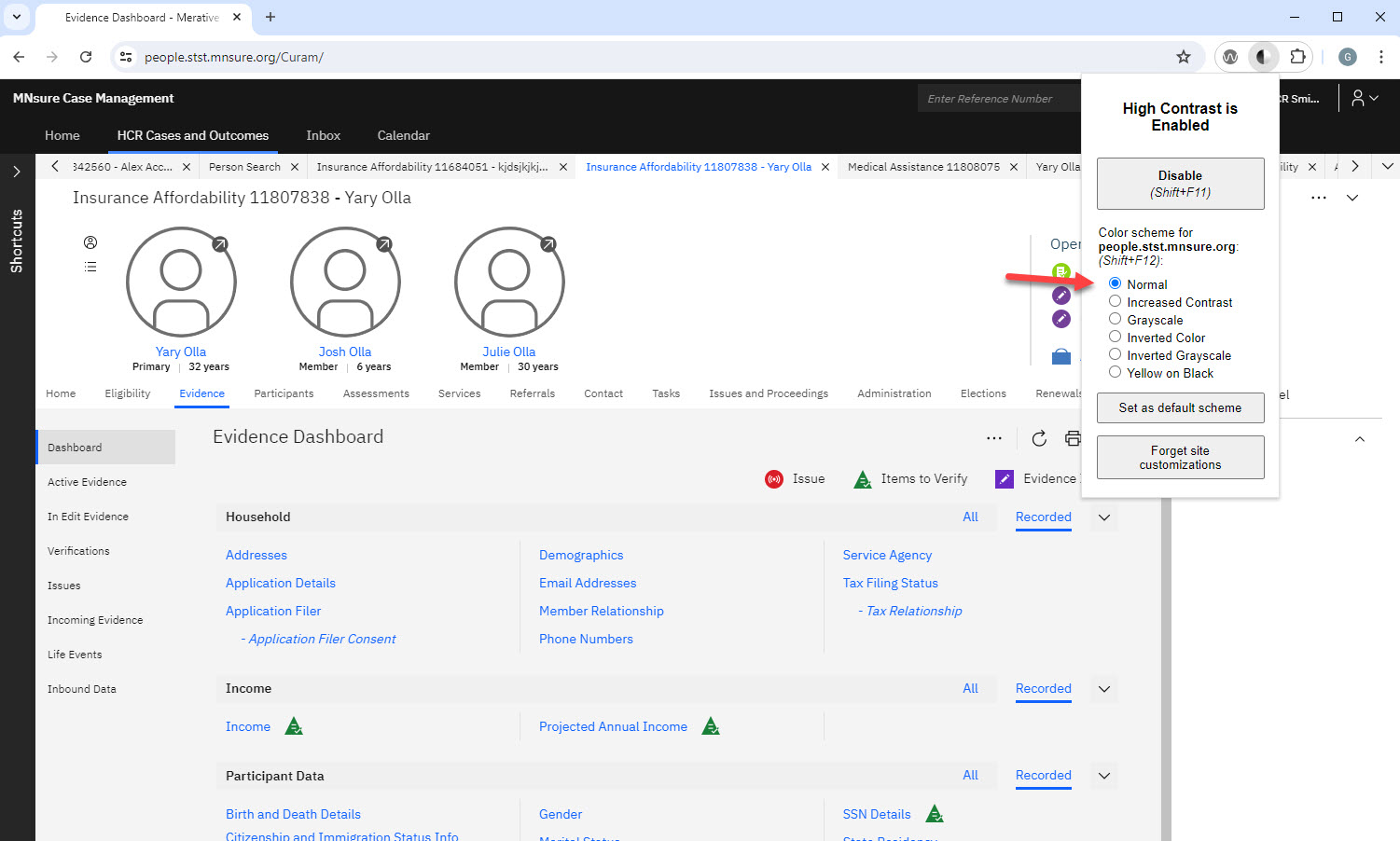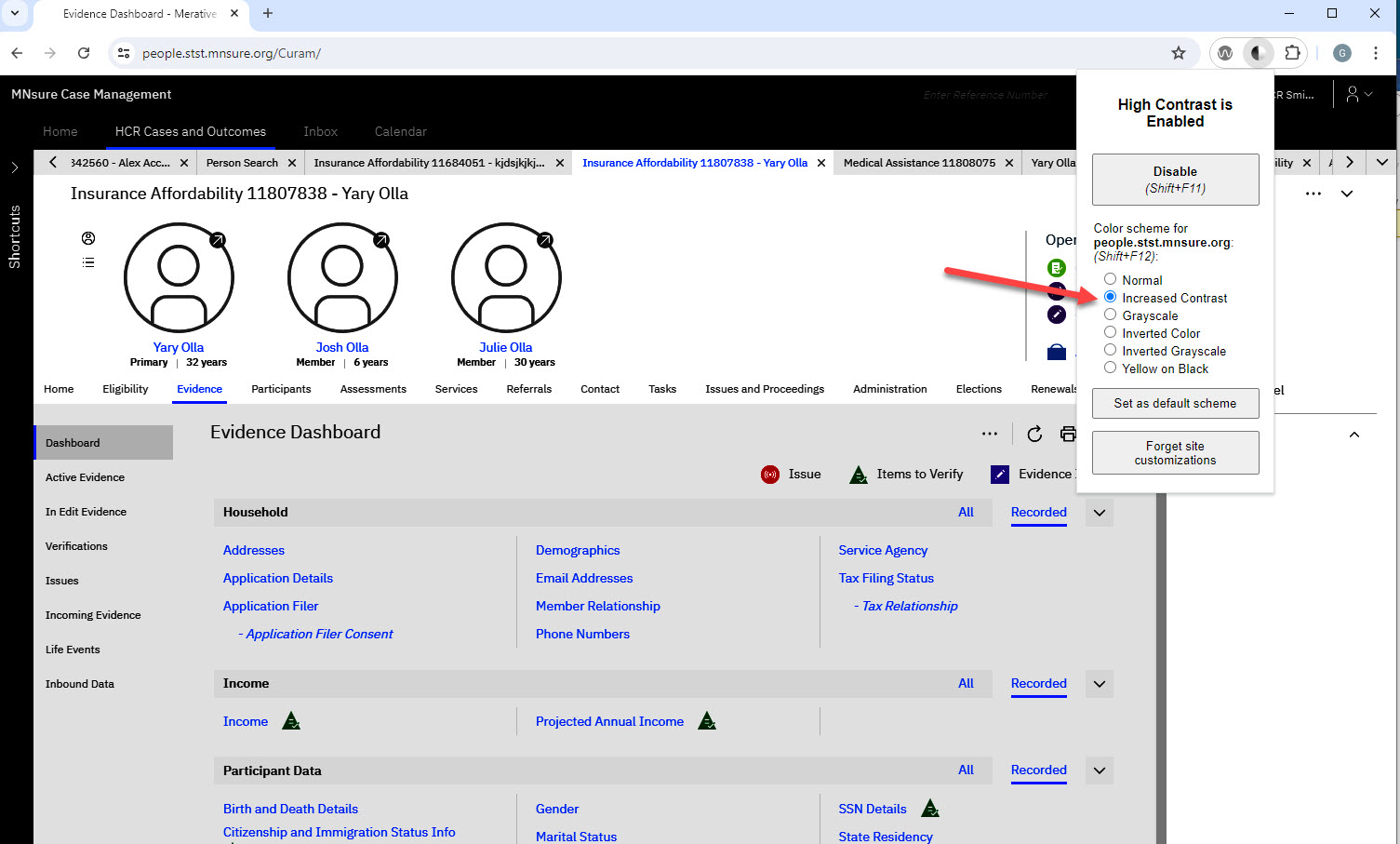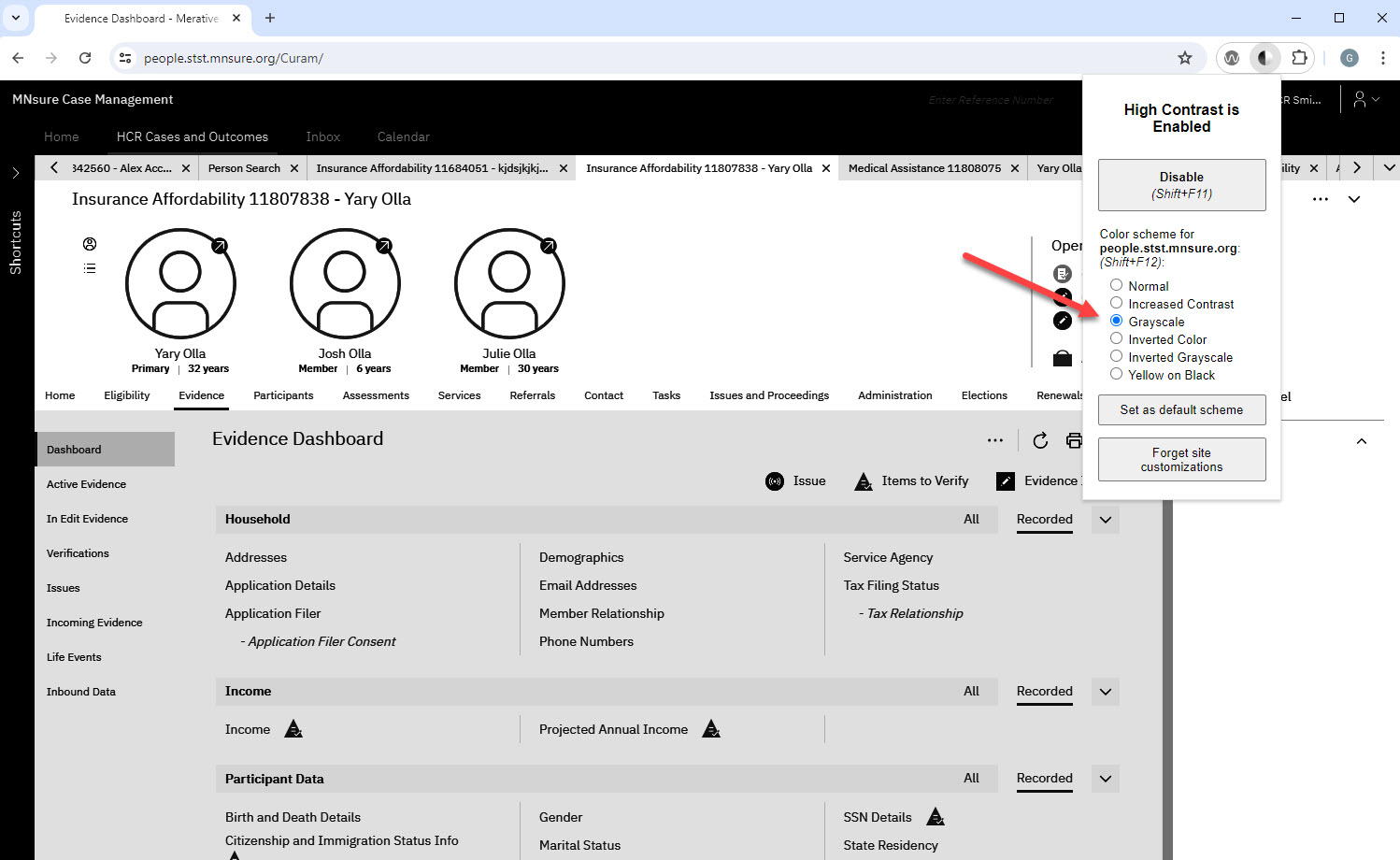 Test and Tools
Test and Tools 
The EAQAT provides quality assurance testing by following QA best practices. This specialized testing combines both manual and automated test types. The EAQAT strives to provide comprehensive accessibility testing in an efficient and thorough manner; thereby, giving the end user confidence that they can successfully access and use state products.
Testing Sites for Accessibility
Testing websites and PDF forms for accessibility requires understanding the fundamentals of accessibility, a set of standard manual tests, experience with automated tools, and an established Quality Assurance process. A proper mix of these ingredients can result in a thorough evaluation of accessibility and usability of websites and PDF documents that will help your end users successfully access and use your products.
EAQAT is skilled and knowledgeable in all areas of accessibility testing. Our experienced accessibility analysts can help your project ensure it complies with state and federal guidelines.
 Manual Testing
Manual Testing
Manual testing for accessibility is accomplished by executing a set of tests which have expected results. These tests are similar to regression tests in that they are repeatable and reusable for any project. Execution of the tests follows established QA processes. Accessibility testing is not the same as functional testing; instead, accessibility testing evaluates the product from the assistive technology end user’s perspective. This includes color contrast, navigation without a mouse, using shortcut keys (keyboard only), and other methods.
The accessibility of interactive content cannot be confirmed by static checks alone.
Testing for Accessibility: Manual Testing
Manual Inspection
Manual inspection of web content and PDFs are vital to accessibility/usability testing. In order to understand the end user experience, manual testing is required. Automated accessibility scan tools do not cover 100% of possible accessibility issues.
The EAQAT maintains a set of standard manual tests in Quality Manager that cover accessibility testing for assigned projects.
Helpful Links for More Information
- This link opens a good, short video on the use of landmark roles. Youtube video on Landmark Roles
- This link explains conformance requirements for using WAI-ARIA markup. Refer to sections 1.6 and 3.4 of the WAI-ARIA specification
- This link points to a table that indicates if a WAI-ARIA attribute is available (optional) and those that are required. Required ARIA roles, states and properties
 Automated Scan Tools
Automated Scan Tools
Automated accessibility scan tools are typically browser extensions which can provide a quick and efficient scan of a website page. These scans give excellent preliminary information about the accessibility and usability of a page within a site. However, the scan does not replace the manual testing using assistive technology tools.
There are many browser extensions that do an excellent job of scanning a page and finding accessibility violations. These tools can provide a wealth of information about the accessibility of a page. Click the link below to read more about automated scan tools.
Testing for Accessibility: Automated Scan Tools
Accessibility scan tools are abundant, and many are free (no license required). These tools are browser extensions that scan the DOM and report accessibility violations.
Which Scan Tool to Choose?
With such a proliferation of scan tools, deciding on which one to choose can be a bit daunting.
Tools Commonly Used by the EAQAT:
- aXe Browser Accessibility Engine
- WAVE - Web Browser Extension
WAVE and aXe are popular accessibility scan tools and do an excellent job of scanning the rendered HTML to provide easy to digest results.
Note, however, that these scan tools, while providing excellent results, have limitations.
Maximize the Potential: Combine accessibility scan tools with a Test Automation Framework, followed by manual testing, to get as much coverage as possible. This will help ensure the assistive technology end users will be able to successfully utilize your products.
Combining accessibility scan tools with a proven automation framework can make these tools work wonders.
Both WAVE and aXe can be activated programmatically. The scan results can be gathered and written to a database. The results can then be saved, analyzed and reported on. Historical trends can be documented, graphed, and analyzed.
Helpful Links for More Information
 Assistive Technology: Screen Readers
Assistive Technology: Screen Readers
Using a screen reader to test website pages is the only true way to experience what an assistive technology user may encounter when navigating a website.
"Screen readers are software programs that allow blind or visually impaired users to read the text that is displayed on the computer screen with a speech synthesizer or braille display. A screen reader is the interface between the computer's operating system, its applications, and the user. The user sends commands by pressing different combinations of keys on the computer keyboard or braille display to instruct the speech synthesizer what to say and to speak automatically when changes occur on the computer screen."
Testing for Accessibility: Assistive Technologies
There are a number of products today that allow visually impaired users to navigate through websites. Using assistive technologies for testing is an essential part of determining if a site is truly accessible and usable.
This page looks at screen readers, and how they are used for testing sites and content for accessibility.
Popular Screen Readers
- JAWS (Windows)
- NVDA (Windows)
- Windows Narrator
- VoiceOver (Mac)
To test for accessibility, use assistive technology or screen readers the way the end user would use the tool(s).
A typical scenario
- Navigate to a site, activate JAWS
- Allow the screen reader to read header information
- Press Insert + F5 to display headings
- Visually inspect the page to verify all heading are visible
- Press Shift + B to display a list of all buttons on a page
- Visually inspect the page to verify all elements that appear as buttons are shown in the list presented by JAWS
As an example: If a visual inspection of a page results in 3 buttons, but only 2 (or 1, or none) are listed when pressing Shift + B, that is a problem for assistive technology end users. They will not know that there are 3 buttons and will not successfully navigate on the page.
Helpful Links for More Information
 PDF Documents and Forms
PDF Documents and Forms
PDF documents and forms are be checked for accessibility and compliance. PDF remediation is the process of evaluating and fixing issues accessibility issues in PDF formatted content.
"PDF includes several features in support of accessibility of documents to users with disabilities. The core of this support lies in the ability to determine the logical order of content in a PDF document, independently of the content's appearance or layout, through logical structure and Tagged PDF.
Testing for Accessibility: PDF Documents and Forms
PDF includes several features in support of accessibility of documents to users with disabilities. PDFs are a common part of many websites, and they require accessible content for all users.
To promote the adoption of PDF/UA, the Matterhorn Protocol was created that contains 31 checkpoints and 136 failure conditions that determine if a PDF file meets the requirements of PDF/UA. PDF/UA is by far the most stringent of the standards and requires the most effort to get a PDF to be compliant.
It is important to know which standard your PDF documents must meet for your organization.
Some may say the Acrobat Accessibility Checker is their base level standard. Some may say WCAG 2.0, WCAG 2.1, and others may say PDF/UA. You'll most likely get a variety of different answers depending on your situation.
Tools for evaluating PDF documents for accessibility
Accessibility quality analysts are equipped with a knowledge of the tools and techniques for making PDF documents accessible for all users. The following tools will help you get started if you haven't considered these before.
PAC 3.0 PDF Checker tool
This free tool does an excellent job evaluating PDF documents for meeting accessibility standards using WCAG 2.0, Levels A, AA, and AAA.
Go here for more information on downloading and using the PAC 3 toolAdobe Acrobat DC Pro for PDF accessibility evaluation
This tool is geared towards creating and evaluating accessible PDF documents. Adobe Acrobat DC’s conformance reports are based on ITI VPAT2.x template, and include information on the revised Section 508 standards from January 2017, corrections to the ICT Final Rule from January 2018, WCAG 2.0, Level AA, and EN 301 549 standard. This site, sponsored by Adobe, provides an overview of the product and its pricing.
Visit this site for more information on Adobe Acrobat DC ProCommonLook PDF is a powerful PDF remediation toolset
Several tools are offered by CommonLook to make PDF compliant documents
Visit CommonLook's website for more information on how these tools can help meet compliance standards for PDFsHelpful Links for More Information
 WAI-ARIA Attributes
WAI-ARIA Attributes
The use of WAI-ARIA attributes is critical to making sites understandable to assistive technology users.
"WAI-ARIA (Web Accessibility Initiative - Accessible Rich Internet Applications) is a specification written by the W3C, defining a set of additional HTML attributes that can be applied to elements to provide additional semantics and improve accessibility wherever it is lacking.""
Testing for Accessibility: WAI-ARIA Attributes
What is WAI-ARIA? Web Authoring Initiative - Authoring Rich Internet Applications
WAI-ARIA is a specification written by the W3C, defining a set of additional HTML attributes that can be applied to elements to provide additional semantics and improve accessibility.
Properly applying WAI-ARIA attributes to HTML elements is as much an art form as a science. The fact that a WAI-ARIA attribute is present, does not ensure that it is appropriate or beneficial to a user of assistive technology.
The EAQAT team is skilled in viewing pages and assessing content for accessibility of a page. We can review the WAI-ARIA labels and determine if they are helpful, not helpful, or missing.
Helpful Links for More Information
 Document Structure
Document Structure
Document structure is the use of landmark roles in a page, an often overlooked yet vitally important part of making sites accessible.
"Providing solid structure is a core accessibility principle that you can apply to content in a range of digital formats, not only HTML. If you provide content in formats such as Microsoft Word or Adobe PDF, that content is more accessible to people with disabilities when it's provided with semantic structure, including headings, lists and tables.
Testing for Accessibility: Document Structure
Proper HTML5 Document Structure
Understanding how to properly structure your documents is crucial to ensuring that your pages are interpreted and presented correctly to the user.
What is Proper Dcoument Structure and how do I ensure documents are structured properly?
One way to describe the structure of HTML5 documents is to picture them as series of sections and subsections. These sections can in turn be visualized as a document outline. Much like a table of contents. This outline is important to making sure that your content is read and displayed correctly.
A solid document structure not only makes your content easier to read it also makes it easier for search engines, screen readers, and other user agents to navigate and find relevant information
HTML allows web designers to structure documents in a way that illustrates the meaning of the content. This is often referred to as semantics.
HTML5 Semantic Elements for Structuring Documents
Semantic Sectioning Elements
- Nav
- Heading H1-H6
- Article
- Section
- Aside
Semantic Grouping Elements
- Main
- Header
- Footer
Helpful Links for More Information
 Office 365 Accessibility
Office 365 Accessibility
Office 365 documents, spreadsheets, diagrams and presentations should be tested for accessibility.
"With a digital transformation solution that is accessible by design, accelerate your journey toward a more productive, inclusive, and compliant workplace."
Testing for Accessibility: Office 365 Products
Office 365 is a suite of products which product documents, spreadsheets, diagrams and presentations. These all need to be tested for accessibility.
Helpful Links for More Information
- Microsoft Office 365 Accessibility Resources. Office 365 Accessibility Resources
 High Contrast Extention for Chrome and Edge
High Contrast Extention for Chrome and Edge
The High Contrast extension lets you browse the web with your choice of several high-contrast color filters designed to make it easier to read text.
A call to the help desk is required to approve and install browser extentions.
High Contrast browser Extentions for Chrom and Edge
The High Contrast browser extension for Chrome and Edge can make screens easier to see for those who have difficulty reading text on some screens. Users can enhance screen readability by choosing a contrast mode that suites them best.
Browser extensions are programs that can be installed on a browser to add functionality. The High Contrast extension is an effective tool for allowing users to customize the appearance of the text colors on their web browsers.
High Contrast Samples
Normal Contrast

Increased Contrast

Grayscale
